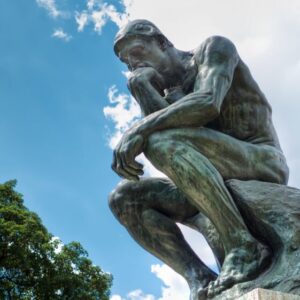
The holy places are rumbling at what is happening in the world.
Apache Stronghold founder (San Carlos Apache) Wendsler Nosie Sr.
In late May, after a four-year battle in the lower courts, the US Supreme Court declined to grant further review in the case of Apache Stronghold v. United States.
The petitioner, a nonprofit Apache and Native American advocacy organization based in San Carlos, AZ, sought to persuade the court to overturn a Ninth Circuit Court of Appeals decision upholding a 2014 federal land transfer of more than 2,000 acres of the Tonto National Forest in Southeast Arizona to Resolution Copper. That company is a jointly owned subsidiary of the world’s two largest global mining companies, Rio Tinto and BHP. The land in question sits atop one of largest and most valuable copper reserves in the world.
There’s no doubt—and the government agrees—that mining the copper will completely destroy an irreplaceable sacred site of Apache peoples named Chi’chil Bildagoteel, known in English as Oak Flat.
The petitioners in the case sought protection under the Religious Freedom Restoration Act (RFRA), a 1993 federal statute which raised the bar for justifying government actions that substantially burden religion. The Ninth Circuit, in a sharply divided 6–5 decision, let the land transfer stand. With the Supreme Court’s denial of further review, essentially the courts have determined that sacred sites on what is now federal property are not protected from impairment or even complete destruction.
The courts’ rejection of religious freedom claims in this case is a definitive blow to what is (or was) arguably the strongest winnable legal rationale available to Oak Flat’s Apache protectors. But this is not yet the final word on Oak Flat’s fate, as two related lawsuits on other grounds have been filed in the district court. However, this is an uphill fight against a 60-day statutory deadline to finalize the land transfer, which was triggered on June 16, when the US Forest Service issued its Final Environmental Impact Statement on the Resolution Copper project.
The case won support from hundreds of non-Native religious groups across the political spectrum, confirming Apache Stronghold founder (and former San Carlos Apache Tribal chairman) Wendsler Nosie’s admonition that “this is a war on all religious ways…Native ways, non-Native ways.” As Nosie suggests, the fate of Oak Flat could have broad implications for both Indigenous sovereignty and religious freedom.
More Mining, More Harm
A 2021 study of 5,336 US mining properties found that a vast majority of the metals needed for clean energy—79 percent of lithium, 68 percent of cobalt, 89 percent of copper, and 97 percent of nickel—lay within 35 miles of Native American reservations. More than one million Native Americans were estimated to live within 6.2 miles (10 kilometers) of metals mining as of 2017. The vast remaining deposits are primarily located in the Southwest, the Great Basin, the Upper Midwest and Upper Plains, the Pacific Northwest, and Alaska.
Whether the focus is on clean energy…or the Trump administration’s “energy dominance” agenda, new mining threatens to further scar valuable places for Native people.
Whether the focus is on clean energy and electric vehicles or the Trump administration’s “energy dominance” agenda, new mining threatens to further scar valuable places for Native people—depleting and reducing access to sacred and culturally important sites, as well as critical sources of food, water, and medicine.
Additionally, there are severe pollution impacts; toxic waste from metals mining comprises 44 percent of pollution (by mass) counted in the US Environmental Protection Agency’s Toxics Release Inventory. This is on top of well-documented negative health effects arising from tens of thousands of abandoned hard rock mines, including more than 500 uranium mines in or near Navajo Nation territory.
Mining affects Native lands both on and off reservation, as well as more expansive ancestral areas, ceded and unceded, in surrounding regions—much of which is now federally owned. Ancestral areas tend to be where larger projects (and particularly nonfuel mining projects) are located and under development today. Examples include the Thacker Pass lithium mine in northern Nevada, the Tamarack nickel mine in central Minnesota, and the massive Pebble Mine project in Bristol Bay, AK. The land for these projects is accessed through federal and state leases or exchanges, sometimes in combination with private transactions.
The Trump administration plans to expand and expedite mineral resource extraction in a bid to restore “America’s Mineral Dominance.” “Immediate measures” of this effort have been dictated by executive order, including directing agency heads and the chair of a new National Energy Dominance Council to create a fast-track pipeline for “priority projects that can be immediately approved or for which permits can be immediately issued.”
Additionally, the secretary of the interior is directed to prepare a list of federal lands containing mineral resources and to prioritize “mineral production and mining related purposes as the primary land uses in these areas.”
Further, the secretary of defense is authorized to advance domestic mineral production under the Defense Production Act and other war powers, and the US International Development Finance Corporation is now specifically authorized to execute loans and other financial facilities to promote domestic mineral production, presumably by way of agreements with other countries.
This is not even to mention the administration’s reckless legal rationale for justifying executive power to “liberate” public lands for energy extraction by eliminating national monument areas set aside for protection under the federal Antiquities Act of 1906.
Trump’s extreme domestic mining agenda is all the more alarming in view of emerging global supply constraints. Over the next three decades, for example, to provide enough electricity for “business as usual” economic growth, global copper production alone must more than double (in aggregate) as compared to the entirety of all previous production up to 2018. This doesn’t even consider clean energy targets, according to researchers at the University of Michigan and Cornell University.
Domestic lithium mining is the biggest emerging battleground. Today, there is only one small lithium mine operating in the United States—the Albemarle Silver Peak mine in southwest Nevada. Yet currently, 72 lithium mining projects are proposed, with some already under construction. Nine of them are located within 10 miles of Native American reservations.
Disappearing a Holy Place
Oak Flat is located in the Tonto National Forest roughly 75 miles east of Phoenix. The huge mining operation would extract as much as 40 billion pounds of copper ore over four decades, using a process known as block cave mining. As a result, Oak Flat would vanish into a crater 1,000 feet deep and two miles wide. Immense and potentially disastrous toxic tailings held back by a 490-foot dam and massive water use, will further harm the area.
The specific government action challenged in the Apache Stronghold case was a 2014 congressional land transfer authorization between the US Department of Agriculture and Resolution Copper. This was a federal giveaway of immense proportions and more than 10 years in the making when it was included as a midnight rider in a must-pass defense funding bill after multiple previous standalone bills failed to pass in the wake of the discovery of copper under Oak Flat in 1995.
Although the specifics of the battle for Oak Flat clearly echo the long US government history of suppressing and criminalizing Native American rituals and beliefs, it should be emphasized for global perspective that Rio Tinto’s designs on Oak Flat fit a pattern of previous acts of Indigenous cultural destruction in other countries.
Oak Flat remains a sacred site…it is a home to the Sunrise Ceremony, a coming-of-age ritual for young Apache women, among other religious activities.
In 2020, the company blasted an Aboriginal sacred cave site in the Juukan Gorge of the Pilbara region of Western Australia to expand one of its 17 iron ore mining operations. This act was carried out with government consent that was not rescinded even after archeologists discovered that the site was more than twice as old as previously thought, with 46,000 years of continuous occupation and containing a rich treasury of artefacts including sacred objects.
The risks of mining megaprojects are also sharply underscored in the corporate track record of BHP, which reached a $30 billion settlement with Brazil in 2024 (and is facing a $47 billion class action lawsuit) for a tailings dam collapse that killed 19 people and damaged over 400 miles of the sacred Doce River in southeast Brazil—considered to be Brazil’s worst environmental disaster.
Oak Flat is part of the ancestral homelands of at least 10 federally recognized tribes, and at least two Western Apache Bands and eight Apache clans have documented traditional ties to the site. Currently, members of the San Carlos Apache Tribe in particular have a close identity with and long family ties to the site.
The San Carlos Reservation, roughly 15 miles from the Oak Flat area, was established in 1872 essentially as a prison camp for Apache removal, to clear the way for mining by White settlers. A precipitating event of the removal was what is known as the Camp Grant Massacre in 1871. More than 100 Aravaipa and Pinal Apaches living in a government-protected settlement north of Tucson, mostly women and children, were slaughtered by a vigilante mob and at least 30 children were enslaved. As social archaeologist John R. Welch explained in a 2017 paper, a 15-month campaign in the wake of the massacre “killed or captured almost all Western Apaches reliant on lands beyond the newly designated reservation borders.”
Oak Flat remains a sacred site and gathering ground for Apache people and others; it is a home to the Sunrise Ceremony, a coming-of-age ritual for young Apache women, among other religious activities. As its advocates have explained, Oak Flat is a direct corridor to the Creator, where powerful mountain spirits known as the Ga’an reside. In US Senate testimony in 2013, San Carlos Tribal Chairman Terry Rambler stated, “Without the power of Gaan, the Apache people cannot conduct our ceremonies…we will become vulnerable to a variety of illnesses and our spiritual existence will be threatened.” Testifying in the federal District Court of Arizona in 2021, Wendsler Nosie’s granddaughter, Naelyn Pike, went further: If the mining activity continues, she said, “then we are dead inside. We can’t call ourselves Apaches.”
The Religious Battle for Oak Flat
The clear but surprisingly controversial question at issue in the Apache Stronghold case was whether a federal land transfer violates Apache religious freedom under RFRA by not only restricting Apache religious practices and beliefs but permanently ending them by destroying Oak Flat. As explained in Apache Stronghold’s petition to the Supreme Court:
[The Ninth Circuit] majority didn’t dispute that the government’s actions ‘will categorically prevent the Apaches from participating in any worship at Oak Flat because their religious site will be obliterated.’ Nor did it dispute that categorically preventing religious exercise is a substantial burden under RFRA’s ordinary meaning.
Instead, the court held that RFRA’s “ordinary” (broadly understood) meaning of substantial burden could not apply to the land transfer policy because RFRA did not intend to encompass federal actions in managing and disposing of its own property. In fact, as the petitioners correctly explained, RFRA specifies that it applies to “all Federal law, and the implementation of that law, whether statutory or otherwise.” The statute authorizing the USDA land transfer to Resolution Copper is a federal law. RFRA further clarifies that it applies to the use of “real property” for purposes of religious exercise, and the law states no exception for federally owned lands.
By excluding federal property from RFRA’s reach and its ordinary meaning of substantial burden, the court was able to fall back on an earlier free exercise case, Lyng v. Northwest Indian Cemetery Protective Association (1987). Lyng denied several Northern California Tribes injunctive relief from a federal forest road project that would have affected spiritual activities associated with nearby sacred burial sites (the project ended up being scrapped for other reasons).
The destructive course of rising lithium demand for electric vehicles can be held in check by transportation policies to reduce car-dependency.
As a question of free exercise, the court found that no relief was warranted because, although the government action at issue could “virtually destroy the…Indians’ ability to practice their religion,” the negative effects of the road project would not entail government coercion of individuals to violate their beliefs. The Ninth Circuit Court of Appeals majority in Apache Stronghold concluded similarly (and even more astonishingly) in denying Oak Flat’s Apache protectors relief from having their irreplaceable sacred site destroyed by a copper mine.
Legally, the clearest way forward from Apache Stronghold is for Congress to specifically amend RFRA. There is also a narrower pathway with specific legislation for specific sites, as with the Save Oak Flat From Foreign Mining Act of 2023, introduced by the late Representative Raúl Grijalva (D-AZ).
Ultimately, however, the destruction at hand should be understood and opposed for what it is: As a matter of federal policy, it has been decided that Western Apache sacred land and cultural survival should be sacrificed for a fortune in copper ore. Thus, the Apache removal that cleared the way for Arizona’s now nation-leading mining industry 150 years ago is brought full circle in the “murder [of] the Apache religion and heritage,” as Naelyn Pike has stated.
There Is an Alternative
Thankfully, reform-minded experts are hard at work developing alternative pathways to limit mining expansion. According to research by Thea Riofrancos and colleagues at the Climate and Community Institute, the destructive course of rising lithium demand for electric vehicles can be held in check by transportation policies to reduce car-dependency, in combination with robust recycling of battery materials, as well as rules and policies to promote smaller vehicles with smaller batteries.
This is a bold policy vision, and it requires a greater solidarity with those directly affected by mining construction, operations, and legacy impacts and risks.
Whether the path is for clean energy development or “American mineral dominance,” the driving goal is corporate self-enrichment from the resources of public land; all too often this is found to be lawful notwithstanding the value of the land in any other sense including sacredness.
The holy places are rumbling at what is happening in the world, indeed.
But where to turn now, when backing down is not an option, is an urgent question. Congress should act, and prayerful action to help Oak Flat’s protectors hold the ground could take many forms, long overdue.














